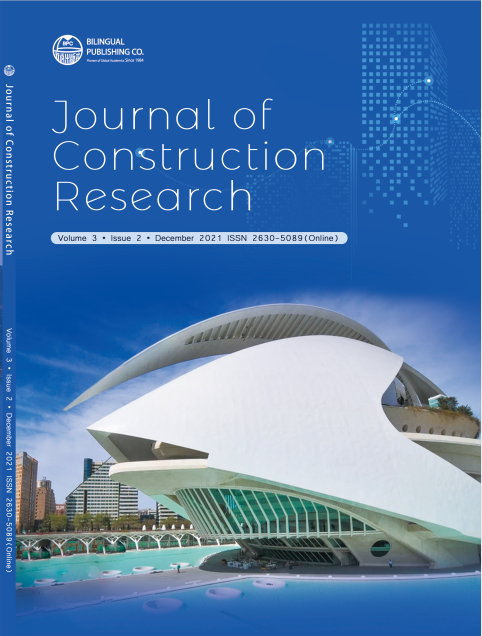Evaluation the Effects of Coarse Aggregates Size on Concrete Properties
DOI:
https://doi.org/10.30564/jcr.v3i2.4049Abstract
Concrete is the most generally used construction material in buildings,pavements, and infrastructures. Concrete is a construction materialcomposed of cement as binder, fine aggregates and coarse aggregatesmixed with water which hardens with time. Concrete is a versatileconstruction material within the housing industry of the planet. Thestandard of the concrete is tormented by various factors and from thosevarious factors which may have an effect on the concrete quality are, thecoarse combination size has its own nice role on the standard of concreteproduction. A laboratorial experiment was conducted to work out the resultscoarse aggregates size on recent and hardened concrete properties. For thisstudy totally different crushed volcanic rock aggregates sizes were collectedfrom almost Jimma city for determination of the results of coarse aggregatesizes in concrete production. Three coarse aggregate nominal sizes of 10mm, 14 mm and 20 mm were used for samples production to envision thescale effects on concrete properties. For this study the procedures that wasfollowed, the types and quantity of materials for concrete creating weresimilar whereas sizes of nominal basaltic coarse aggregate were different.The fresh concrete has a slump value of 67 mm, 72 mm and 83 mm for10mm, 14 mm and 20 mm aggregate sizes respectively. A total of thirty sixconcrete cube samples were ready and tested using compressive strengthtesting machine at totally different ages of the cube 7 days, 14 days, and 28days, to know their strengths. The compressive strength was 23.524 Mpa,22.643 Mpa and 22.41 MPa for aggregate sizes of 10 mm, 14 mm and 20mm respectively. The laboratory results show that 10mm coarse aggregatesize gave the most effective compressive strength and comparativelylowest slump at similar water/cement ratio of 0.6. At 28th day 10mmcoarse aggregate size gave 23.524 Mpa compressive strength which is themaximum compressive strength from the remainder coarse aggregates so,the optimum maximum size of coarse aggregate for this study was 10mm.Keywords:
Aggregate Sizes, Concrete, Concrete properties, Compressive strength, SlumpReferences
[1] Neville, A.M., Brooks, J.J., 2010. Concrete technology (second Edition). London: second Edition.
[2] Abayneh, Mikyas, June 1987. Construction Materials, A Teaching Material. Addis Ababa: Addis Ababa University Press.
[3] Aginam, Chidolue, Nwakire, 2013. Investigating the Effects of Coarse Aggregate Types on The Compressive Strength Of Concrete. International Journal of Engineering Research and Applications (IJERA). 1140-1144.
[4] Ajamu, S.O., 2015. Effect of Coarse Aggregate Size on the Compressive Strength and. Journal of Engineering Research and Applications. 67-75.
[5] American Concrete Institute Supersedes, E1-99. E1-07, ACI Education Bulletin. 2007.
[6] Dinku, Abebe, 2005. The Need for Standardization of Aggregates for Concrete Production in Ethiopian Construction Industry. International Conference on African Development. Michigan: Western Michigan
[7] Ethiopian Standard, ES.C.D.201.1990. Specific University. 1-16.Gravity for fine Aggregate.
[8] Gambhir, M L., 2013. Concrete Industry. In Concrete technology, by MGHILL, 763. New Delhi: McGRAW HILL EDUCATION.
[9] Ganesh Kumar S., Zeryhun Mulu Dinesh S., 2018. Comparitive Study On Engineering Propoerties Of The Aggregates And Compressive Strength Of Conventional Concrete Using Crushed And River Gravel, Coarse Aggregates Around Jimma Zone. International Research Journal of Engineering and Technology (IRJET): 496-506.
[10] Ige, Ajamu, 2015. Effect of Coarse Aggregate Size on the Compressive Strength and the Flexural Strength of Concrete Beam. S.O. Ajamu Int. Journal of Engineering Research and Applications: 67-75.
[11] Mitchell, Clive, 2015. Construction aggregates: evaluation and specification. Nottingham, UK. 1-7.
[12] Mohammadi, Emadaldin, Behnood, Ali, Arashpour, Mehrdad, 2019. Predicting the compressive strength of normal and High-Performance Concretes using ANN and ANFIS hybridized with Grey Wolf Optimizer. Elsevier: 1-14.
[13] Neville, A.M., 1987. Concrete Technology. New York: Longman Scientific & Technical Series.
[14] Neville, A.M., 2011. Properties of concrete, 5th edition. p.Cm.
[15] Wickpidia, Jan 12, 2014.The Effect of Aggregate Properties on Concrete. https://www.engr.psu.edu/ce/courses/ce584/concrete/library/materials/aggregate/aggregatesmain.htm (Accessed 10 26,2019).
Downloads
Issue
Article Type
License
Copyright and Licensing
The authors shall retain the copyright of their work but allow the Publisher to publish, copy, distribute, and convey the work.
Journal of Construction Research publishes accepted manuscripts under Creative Commons Attribution-NonCommercial 4.0 International License (CC BY-NC 4.0). Authors who submit their papers for publication by Journal of Construction Research agree to have the CC BY-NC 4.0 license applied to their work, and that anyone is allowed to reuse the article or part of it free of charge for non-commercial use. As long as you follow the license terms and original source is properly cited, anyone may copy, redistribute the material in any medium or format, remix, transform, and build upon the material.
License Policy for Reuse of Third-Party Materials
If a manuscript submitted to the journal contains the materials which are held in copyright by a third-party, authors are responsible for obtaining permissions from the copyright holder to reuse or republish any previously published figures, illustrations, charts, tables, photographs, and text excerpts, etc. When submitting a manuscript, official written proof of permission must be provided and clearly stated in the cover letter.
The editorial office of the journal has the right to reject/retract articles that reuse third-party materials without permission.
Journal Policies on Data Sharing
We encourage authors to share articles published in our journal to other data platforms, but only if it is noted that it has been published in this journal.




 Mamaru Dessalegn Belay
Mamaru Dessalegn Belay

